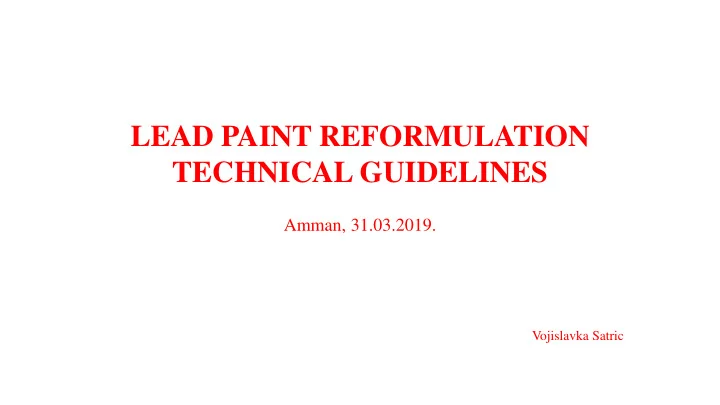

LEAD PAINT REFORMULATION TECHNICAL GUIDELINES Amman, 31.03.2019. Vojislavka Satric
CONTENT 1. Technical Guidelines Content; 2. Colours and Paint Function; 3. Paint Raw Materials; 4. Lead Compounds in Paints; 5. Substitution Process; 6. Assessment of Alternative Pigments and Additives; 7. Reformulation Processes.
1. Technical Guidelines Content • Information on hazardous properties of lead compounds; • Substitution process; • Colour theory and colour index; • Dispersion process; • Alternative pigments and additives; • Assessment of alternative pigments and additives; • General information on reformulation processes;
• The Technical Guidelines are developed to help address both capacity constraints and technical barriers to the substitution of lead compounds in paints • Focus is on SMEs needs for the effective and efficient reformulation of paint.
2. COLOURS AND FUNCTIONS OF PAINT
COLOURS
Paint Functions - Protection
Paint Functions – Protection (1)
Paint – Signal/Camouflage Function (2)
Paint Functions (3) • Decorative, • Insulation, • Conductivity, • Antibacterial, • Fire retardant
Paint Functions (4) • Paint is also formulated to adapt to a variety of substrates and methods of application.
• Since there are many different initial lead-containing formulations for colour and other paint properties, Technical Guidelines may provide only general information about reformulation processes. • In-depth analyses and more specific data will be provided through the pilot demonstrations in the GEF Lead Paint Project to participating companies according to their specific needs.
3. Paint Raw Materials • Resins (vehicle) • Pigments • Extenders • Additives • Solvents (can be water)
4. LEAD COMPOUNDS IN PAINTS
Paint Raw Materials that may Contain Lead Compounds (1) Type of paint Pigments Extenders Driers Air-drying primers and x x x topcoats Primers, other bases x x Primer surfacers, other x bases Top coats, other bases x
Paint Raw Materials that may Contain Lead Compounds (2) • Natural extenders or pigments (like ferro oxides) may contain lead compounds; • By using these extenders or pigments, lead compounds may be added unintentionally;
Hazardous Properties of Lead Compounds in Paints Chemical Hazard statements according to GHS PIGMENTS H350 – may cause cancer Lead chromate H360 - May damage fertility or the unborn molybdate sulphate red child H373 - May cause damage to organs through prolonged or repeated exposure H400 - Very toxic to aquatic life Lead chromate H410 - Very toxic to aquatic life with long lasting effects
5. Substitution Process
Lead Compounds Substitution Anticorrosive pigment Red Lead Zinc chromate, Zinc phosphate?, Calcium (poly)phosphate? Pigments for topcoats – Red molybdate, Lead chromate There is a wide choice of possible, non-hazardous alternatives Lead additives (driers) Zirconium or Strontium octoate, Zirconium or Strontium neodecanoate
6. Assessment of Alternative Pigments and Additives
Alternative Pigments Assessment (1) • Alternatives to anticorrosive pigment Red Lead • Alternatives to pigments molybdate orange and lead chromate yellow
Alternative Pigments Assessment (2)
6. REFORMULATION PROCESSES
The main practical problem in (re)formulation is the large number of components present in a paint
Reformulation – Anticorrosive Pigments, Driers • Lead driers and anticorrosive pigments substitution do not require complex reformulation; • Parallel paints testing is necessary to check if reformulation is effective
Reformulation – Pigments for Topcoats • Molybdate orange and Lead chromate cannot be substituted by a single pigment; • Substitution by combination of the organic and the inorganic pigments is necessary; • Pigments choice depend on desired performance properties of a paint
CONCLUSION • Lead is classically a chronic or cumulative toxin. Exposure to lead is a major public health concern; • Lead compounds should have priority in substitution; • There are many pigments and driers available on the market that may effectively substitute lead compounds; • Lead Paint Reformulation Technical Guidelines provide information on alternatives, their assessments and reformulation processes. This helps companies to effectively substitute lead compounds; • We will work with participating SMEs on specific reformulations, according to their needs
THANK YOU! لبيزج اركش Vojislavka Satric
Recommend
More recommend